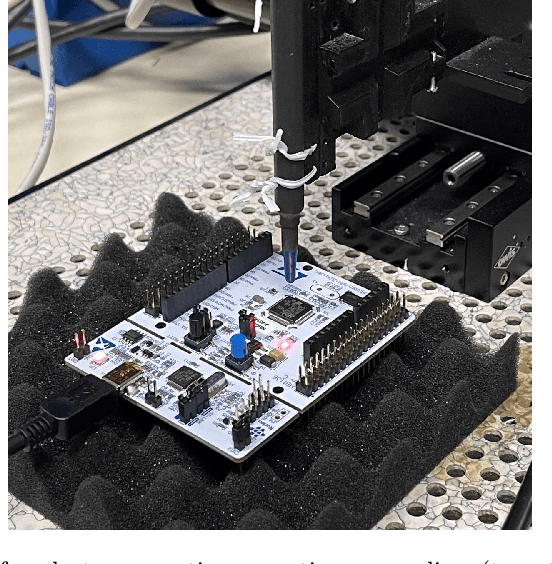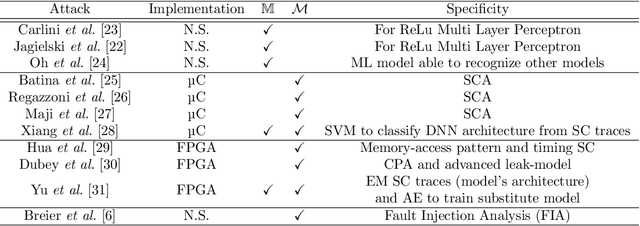Jean-Baptiste Rigaud
Like an Open Book? Read Neural Network Architecture with Simple Power Analysis on 32-bit Microcontrollers
Nov 02, 2023Abstract:Model extraction is a growing concern for the security of AI systems. For deep neural network models, the architecture is the most important information an adversary aims to recover. Being a sequence of repeated computation blocks, neural network models deployed on edge-devices will generate distinctive side-channel leakages. The latter can be exploited to extract critical information when targeted platforms are physically accessible. By combining theoretical knowledge about deep learning practices and analysis of a widespread implementation library (ARM CMSIS-NN), our purpose is to answer this critical question: how far can we extract architecture information by simply examining an EM side-channel trace? For the first time, we propose an extraction methodology for traditional MLP and CNN models running on a high-end 32-bit microcontroller (Cortex-M7) that relies only on simple pattern recognition analysis. Despite few challenging cases, we claim that, contrary to parameters extraction, the complexity of the attack is relatively low and we highlight the urgent need for practicable protections that could fit the strong memory and latency requirements of such platforms.
A Practical Introduction to Side-Channel Extraction of Deep Neural Network Parameters
Nov 10, 2022Abstract:Model extraction is a major threat for embedded deep neural network models that leverages an extended attack surface. Indeed, by physically accessing a device, an adversary may exploit side-channel leakages to extract critical information of a model (i.e., its architecture or internal parameters). Different adversarial objectives are possible including a fidelity-based scenario where the architecture and parameters are precisely extracted (model cloning). We focus this work on software implementation of deep neural networks embedded in a high-end 32-bit microcontroller (Cortex-M7) and expose several challenges related to fidelity-based parameters extraction through side-channel analysis, from the basic multiplication operation to the feed-forward connection through the layers. To precisely extract the value of parameters represented in the single-precision floating point IEEE-754 standard, we propose an iterative process that is evaluated with both simulations and traces from a Cortex-M7 target. To our knowledge, this work is the first to target such an high-end 32-bit platform. Importantly, we raise and discuss the remaining challenges for the complete extraction of a deep neural network model, more particularly the critical case of biases.
A Review of Confidentiality Threats Against Embedded Neural Network Models
May 04, 2021



Abstract:Utilization of Machine Learning (ML) algorithms, especially Deep Neural Network (DNN) models, becomes a widely accepted standard in many domains more particularly IoT-based systems. DNN models reach impressive performances in several sensitive fields such as medical diagnosis, smart transport or security threat detection, and represent a valuable piece of Intellectual Property. Over the last few years, a major trend is the large-scale deployment of models in a wide variety of devices. However, this migration to embedded systems is slowed down because of the broad spectrum of attacks threatening the integrity, confidentiality and availability of embedded models. In this review, we cover the landscape of attacks targeting the confidentiality of embedded DNN models that may have a major impact on critical IoT systems, with a particular focus on model extraction and data leakage. We highlight the fact that Side-Channel Analysis (SCA) is a relatively unexplored bias by which model's confidentiality can be compromised. Input data, architecture or parameters of a model can be extracted from power or electromagnetic observations, testifying a real need from a security point of view.
 Add to Chrome
Add to Chrome Add to Firefox
Add to Firefox Add to Edge
Add to Edge